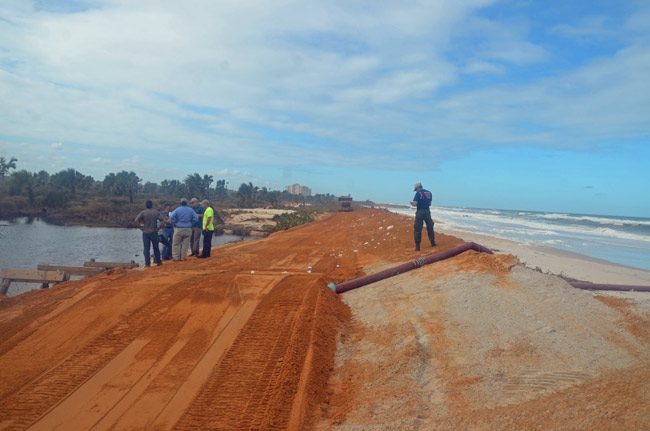
Hurricane Matthew is long gone. Some of the wreckage it left behind has been repaired, at least as temporary fixes. But Flagler County is possibly years and tens of millions of dollars away from restoring its beaches and dunes back to pre-storm conditions, if that’s even possible, leaving most of Flagler’s 18 miles of shoreline shredded and properties and subdivisions on the Barrier Island vulnerable to new dune breaches, even from nor’easter storms.
Flagler Beach, meanwhile, is wrestling with the restoration of its own beaches and the reconstruction of State Road A1A, almost entirely as a bystander to state and federal agencies’ competing preferences on what to do next, how to do it, and whom to bill to do it.
The common denominator is Flagler County government and the county commission. Two of its five members are rookies with just weeks of government experience. One of the seats, that held by the late Frank Meeker, remains vacant five months after Meeker’s death as Gov. Rick Scott inexplicably—and, increasingly to some local residents whose district he represented, unforgivably.
By default, that’s left County Administrator Craig Coffey disproportionately driving the county’s policy train as he tries to make sense, for his administration as much as for the commission, of the innumerable financial, engineering, bureaucratic and political variables (to name a few) that have remade the map of county priorities.
Coffey this afternoon presented the latest of his comprehensive updates on post-Matthew recovery to the county commission, his second in two months. It was all over the map, in this case literally, and through no fault of Coffey’s, who was merely trying to provide an understandable picture of a maze of options and difficulties that belie the public misperception that the disaster is over. A different sort of emergency has taken its place, this one much more drawn out and less tractable than a whistling storm on a weather map. And it will turn out to be very costly.
In raw numbers, 30 to 50 feet of dune width has been sheared off the coastline, for most of Flagler’s 18 miles of coast. That sand is gone, and with it what had been a protective wall that prevented the oceanb from flooding the land to the west. Makeshift dunes at three significant breaches have been built, but Coffey says a nor’easter could breach them.
The county’s financial reserves were at $4.5 million. So far debris clean-up alone has cost $5 million, with $10 million in rebuilding projects ahead, not including county matches for beach projects. The Federal Emergency Management Agency will reimburse some of that, but it takes time. Meanwhile, the county may have to borrow. “Financially I’m walking a tightrope here trying to make sure we don’t make any financial mistakes,” Coffey said.

In sum, dune restoration could cost upwards of $57 million, Coffey said. A further complication: the beach-renourishment project for the area south of the Flagler Beach pier is a separate project entirely, with its own funding stream and requirements.
“It may take us years to get there,” Coffey said of rebuilding the dunes. “It may be a timing issue, it may be a money issue, it may be a matching issue.”
“I’m trying to describe my nightmare to you guys, as well as I can,” he continued (using a term, “guys,” that was used by another director during today’s presentation as well, and that reflects the now-all male make-up of the commission, and an oddly informal approach by the administration: something Barbara Revels, the former chairman of the commission who was being honored later this afternoon, would not have much tolerated).
“We just managed to dodge this bullet for 100 years,” County Commission Chairman Nate McLaughlin said. “It’s come on our watch, gentlemen, it’s come on our watch.”
Dave Sullivan, who replaced Revels and is one of two rookies on the commission—Donald O’Brien is the second—was concerned about a lack of a unified plan for all the issues Coffey was describing. He’d analyzed the issue previously. Addressing what he called “the emotional side, the side we represent,” he said, “Flagler County is a small county compared to the other counties where damage has been, but we’ve got significant damage,” some of its costs exceeding the county’s annual operating budget. “Unless we provide a unified plan for how we’re going to fix this situation, it ain’t going to work,” he said, rattling off the nearly dozen federal and state agencies and local governments involved. “If we’ve got individuals with different priorities, different interests going forward, we’re not going to get the kind of money we’re asking for.”
Flagler Beach city commissioners were all in the audience, themselves eager for something similar to what Sullivan was referring to. They did not hear it this afternoon, principally because the county hasn’t developed such a plan: it’s not even sat down with Flagler Beach to discuss it, though McLaughlin made such a workshop a priority in the next few weeks.
What they did hear was the problematic ways local matches would have to play into any funding formula from state or federal sources, and how the county—that is, Coffey—is exploring increasing the 4 percent sales surtax, to 5 percent, on hotels, motels and other short-term accommodations, to double revenue devoted to beach protection. That revenue is now $250,000 a year. A 5 percent surtax would increase it to $500,000.
It sounded like what the county’s tourism director, Matt Dunn, had been wanting to do for a couple of years, with the perfect opportunity to now do it. McLaughlin, who chairs the Tourist Development Council that oversees the administration of that tourism tax, approves of the idea, but he said he’d want all the revenue generated by the extra penny to be devoted to beach protection, which would neutralize any notion of generating more revenue for the tourism department.
Flagler Beach City Commission Chaiorman Jane Mealy and Flagler Beach mayor Linda Provencher addressed the county’s commissioners to press the point that if Flagler Beach is opposed to sea walls—as it very much is—but Flagler County is not, in some areas north of the city, it could weaken the city’s position.
“We all need to get on the same team and work together on this,” Provencher said.
Ironically, that was the recurring point of agreement in today’s meeting. But it underscored to what extent the issue is fragmented and—worse—to what extent the county’s and the city’s political weight may, in the end, be limited.
No decisions were reached at the meeting other than to hold that meeting with Flagler Beach.
![]()
Click to access flagler-county-beach-plan.pdf





























Ron says
No preplan in place. No surprise here. Government is never proactive, they are reactive. Because of this it will cost the taxpayers more.
snapperhead says
How about putting more TDC funds into reserve for beach renourishment instead of raising taxes or using 2/3 of the bed tax on salaries and promotion, seo/website expenses etc or paying off for profit sports tournaments. The beach sells itself 365 days a year and should be the #1 priority of bed tax funds not a small portion of it.